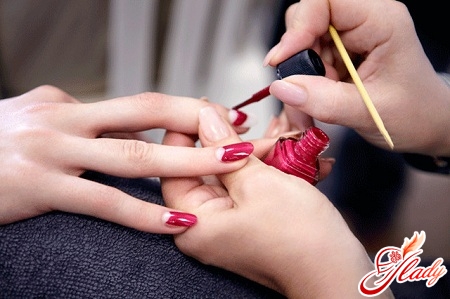 Have you ever thought about what history ismanicure must be thousands of years old? That beautiful, well-groomed nails are not just a tribute to fashion, but a unique culture, aesthetics that have stood the test of time. The very first information that women began to use real manicure sets dates back to the third millennium BC. Incredibly beautiful tools for nail care made of cast gold were found during excavations of Chaldean burials in the ruins of Babylon. Scientists have determined that they are approximately three thousand two hundred years old. Although, who knows what was before! Perhaps our ancestors - primitive women - sat by the fire near the cave and cleaned their nails with a sharp twig in order to paint them in a nice color with some prehistoric plant or berry. Who knows? Despite all the technical progress and development of technology, we still have not learned to accurately look deep into the centuries to reveal the incredible secrets of the past.
Have you ever thought about what history ismanicure must be thousands of years old? That beautiful, well-groomed nails are not just a tribute to fashion, but a unique culture, aesthetics that have stood the test of time. The very first information that women began to use real manicure sets dates back to the third millennium BC. Incredibly beautiful tools for nail care made of cast gold were found during excavations of Chaldean burials in the ruins of Babylon. Scientists have determined that they are approximately three thousand two hundred years old. Although, who knows what was before! Perhaps our ancestors - primitive women - sat by the fire near the cave and cleaned their nails with a sharp twig in order to paint them in a nice color with some prehistoric plant or berry. Who knows? Despite all the technical progress and development of technology, we still have not learned to accurately look deep into the centuries to reveal the incredible secrets of the past.
The Ancient History of Manicure - Ancient Egypt
Although the time machine has not yet been invented, butThere is quite a bit known about the history of manicure. And the first thing worth mentioning is a discovery related to the Egyptian pharaoh Nusser, who lived two and a half thousand years ago BC. Surely this name does not mean anything to you - this is not surprising, because he himself did not distinguish himself in anything special during his life. However, the excavations of his burial made a lot of noise thanks to the mummies of courtiers that archaeologists discovered. In their tombs lay scrolls stating that their position was no more, no less - "keepers of the pharaoh's nails"! This is how our contemporaries learned that the manicure business flourished in ancient Egypt. This guess is confirmed by the book of beauty recipes of the famous queen Cleopatra, where she gives quite practical advice on nail care. Long and beautiful nails were already considered a sign of aristocracy at that time, they were grown and painted in bright colors not only by women, but also by noble men. But the poor were not entitled to such beauty according to their status, and they were content with short nails covered with pastel colors. By the way, many believe that Cleopatra and her entourage painted their nails with henna, because most of the found mummies of noble families had traces of this herb on their nails. However, it has recently been discovered that henna was used during the burial ritual, which is why archaeologists came across mummies with brown nails. In fact, both Cleopatra and all the other nobility of Ancient Egypt painted their nails in a completely different way (presumably, a mixture of fat tail fat with the juice of the dragon tree).
Manicure in ancient China
In ancient China, long and well-groomed nailswere considered not an attribute of beauty, but a sign of the wisdom of their owner. The fact is that the inhabitants of the Celestial Empire of that time believed that it was long nails that helped them “talk” to the gods. Of course, the privilege of being wise (at least externally) was absolutely unavailable to people of the lower classes; they were strictly forbidden to grow and paint their nails. Not only he himself, but also the entire people of China attached special importance to the condition of the emperor’s nails: it was believed that the more well-groomed and healthy the nails of the head of state were, the more prosperous the inhabitants of the Celestial Empire would live. Therefore, a manicure in the emperor’s palace turned into a real ritual ceremony – with spiritual chants and dances. Thanks to these actions, access to positive qi energy was opened, and the emperor immersed himself in harmony with the world around him. In ancient China, there was a unique recipe for nail polish: glue was made from the juice of certain fruit trees, which was added to a mixture of wax, gelatin and egg whites. The concubine who did the emperor's manicure occupied a fairly high position at court and had many privileges in relation to other girls. The manicure itself was done with jade or bamboo sticks, which were delivered to the palace by the best court suppliers. By the way, in the nineteenth century, the Manchu Empress Cixi grew her nails as long as twenty centimeters! To prevent them from breaking and peeling, the court manicurists fed the empress's nails with calcium. There was a daily ritual for this: each nail was steamed in goat's milk in turn, after which it was wrapped in a special case made of pure silk. Noble ladies tried to imitate their empress and also grew their nails quite long (they were allowed about five centimeters). They painted them bright red, drew wonderful birds on them and even wrote short haiku in hieroglyphs! But what should those who suddenly entered high society do and could not immediately grow such long nails? Such people simply... extended them! Yes, yes, do not be surprised, because this procedure was not invented by contemporaries, but by our ancestors many, many years ago. Even in Ancient Egypt and Babylon, skillfully made nails made of silver and pure gold were applied to the nail plate. But the Red Indians (though this was much later), without further ado, glued claws of various animals to their own nails. The most advanced method of extension was used by the inhabitants of the ancient Celestial Empire: long nails were created from glued rice paper.
The importance of nails for the inhabitants of Ancient Rus
In terms of nail care, our ancestorswere "ahead of the rest of the world", but this only concerned superstitions. The soul of a Russian person has always been full of secrets and mysteries, and therefore it is not surprising that the attitude to nails was very special. In particular, it was allowed to cut nails strictly once a week - on Thursday, otherwise a person could get sick or misfortune would befall him. After the nails were cut, they were burned, and the ashes were scattered in the wind. However, it was believed that any disease can be cured if you burn the cut nails of an unhealthy person and bury them in the ground at a crossroads. Even more surprising prohibitions applied to shepherds: they were not allowed to cut their nails during the grazing season. The fact is that shepherds entered into real agreements with the wood goblin - the owner of the forest, according to which they could not kill forest birds and animals, slaughter their own cattle, or cut their nails. After all, according to legend, it was in the nails that the physical and magical power of a person was contained, and the longer they were, the stronger the bond between the parties to the contract. If you think that all these "superstitions" are in the past, then you are deeply mistaken: in some Russian villages, nails are still cut once a week to avoid the tricks of evil spirits. And here are a few more beliefs that are very popular today:
- People with crooked nails have an unhappy, short life;
- If a pregnant woman steps on a piece of trimmed nail, she may have a miscarriage;
- Do not cut nails to babies for up to a year, otherwise they will live in poverty;
- If you spit three times on the nail, cut and divided into three pieces, you can get rid of spoilage and evil eye.
On the other hand, already in the nineteenth centuryRussians did not lag behind fashionistas from other countries in their desire to make their nails beautiful and well-groomed. It was at this time that the heyday of the history of manicure art occurred.
The latest history of manicure
The art of manicure in the form in which weпривыкли его видеть, зародилось в середине девятнадцатого века. В 1830 году у французского короля Луи Филиппа случилась неприятность – воспалился заусенец на руке. Для решения проблемы был вызван врач, который отнесся к делу со всей ответственностью: он принес собою набор инструментов для безопасного лечения пальца. В этот набор входили: увлажняющая мазь, белила, замшевая пилочка и апельсиновая палочка, позаимствованная из зубоврачебных инструментов. Позже этот «королевский набор по уходу за ногтями» получил распространение по всей Европе. В начале двадцатого века вся Европа и Америка красила ногти с помощью крема и блестящей пудры. Из этих ингредиентов делали густую пасту, совсем не похожу на современные лаки. Для окрашивания использовалась специальная кисточка из верблюжьей шерсти, которая стоила немалых денег. Самым главным недостатком такого «окрашивания» было то, что пудра держалась на ногтях не больше суток, да и то при очень бережном к ней отношении. И только в 1917 году в Соединенных Штатах Америки был изобретен первый настоящий лак для ногтей, и был он розового цвета. Такое новшество надело немало шума среди модниц и модников того времени (мужчины не менее активно пользовались маникюром). Уже в двадцатые годы прошлого столетия в аптеках всего мира можно было купить лак для ногтей практически любого оттенка. Но, пожалуй, более всего развитием маникюр обязан кинематографу. Как только черно-белое немое кино сменилось цветным, вопрос об ухоженных ногтях киноактрис встал ребром. Режиссеры начали снимать кино крупным планом, все мельчайшие недостатки во внешности женщины оказались «как на ладони». Мало кто из актрис могли похвастаться прекрасными ногтями от природы, а потому, стилисты того времени немало поломали голову над созданием «имплантатов». Эксперименты впечатляли, ведь в ход шло абсолютно все: обрезки кинопленки, небольшие кусочки пластика, картон, одноразовые чайные пакетики. Неизвестно, сколько бы все это продолжалось, если бы не одна случайность: как-то один стоматолог поранил себе ноготь. Не найдя под рукой подходящих медицинских препаратов, он замазал срез составом для пломбы. На следующий день доктор с удивлением заметил, что ноготь не только не болит, но и выглядит совершенно естественно. Говорят, что именно так появилось акриловое наращивание ногтей. Еще по одной легенде, некий врач (тоже стоматолог) хотел отучить свою жену от вредной привычки – та частенько грызла свои ногти. Для этих целей он намазал ей ногтевые пластины акрилом, дабы она их больше не кусала. Совершенно неизвестно, оставила ли его супруга столь вредную привычку, но вот то, что семидесятые-восьмидесятые года прошлого века стали настоящим бумом в области акриловых ногтей – факт очевидный. На сегодняшний день красивые, ухоженные ногти – это незаменимый атрибут каждой современной женщины — такой же, как красивая прическа или чистая кожа. Ежегодно в России открываются пятьсот-семьсот салонов красоты, в каждом из которых есть и маникюрный кабинет. Лаки для ногтей становятся все безопаснее, методы наращивания – совершеннее. Вполне возможно, что в скором будущем откроются новые горизонты маникюрного искусства – столь неожиданные и простые, что каждая домохозяйка сможет сделать себе супер-маникюр на дому. Возможно. А пока представляем вашему вниманию несколько интересных фактов о ногтях.
Curious facts about nails:
- on the hands of the nails grow almost twice as fast as on the legs.
- At night, nails grow much faster than in the daytime.
- in men, nails grow much faster than women.
- During pregnancy, nails grow faster.
- left-handed fingernails grow faster on the left hand, the right-hander on the right.
- injured or bitten nails grow faster.
- at owners of long fingers fingernails grow faster.
- The warmer the climate, the faster nails grow.
- after a cold, nails grow twenty percent faster.
- After twenty years and every year the nails grow more slowly.
We recommend reading:









